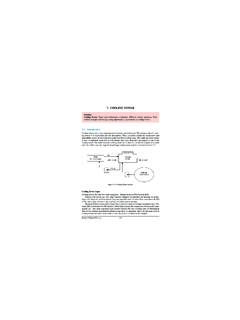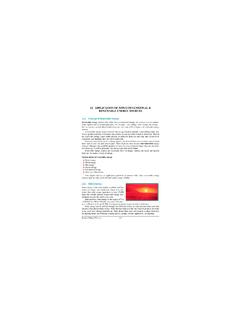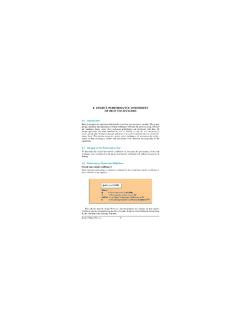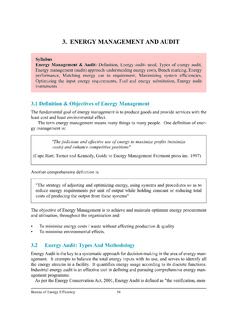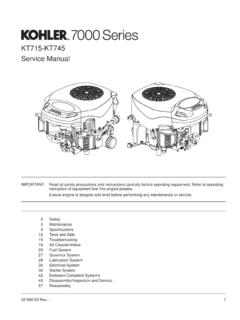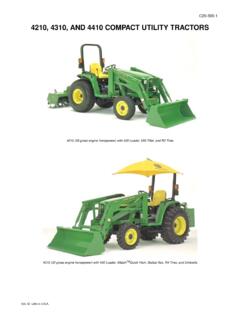Transcription of 5. FANS AND BLOWERS - Bureau of Energy Efficiency
1 5. fans AND BLOWERS93 Bureau of Energy EfficiencySyllabusFans and BLOWERS :Types, Performance evaluation, Efficient system operation, Flowcontrol strategies and Energy conservation IntroductionFans and BLOWERS provide air for ventilation and industrial process requirements. fans generatea pressure to move air (or gases) against a resistance caused by ducts, dampers, or other com-ponents in a fan system. The fan rotor receives Energy from a rotating shaft and transmits it tothe between fans , BLOWERS and CompressorsFans, BLOWERS and compressorsare differentiated by the methodused to move the air, and by thesystem pressure they must oper-ate against.
2 As per AmericanSociety of Mechanical Engineers(ASME) the specific ratio - theratio of the discharge pressureover the suction pressure isused for defining the fans , BLOWERS and compressors (seeTable ). Fan TypesFan and blower selection depends on the volume flowrate, pressure, type of material handled, space limita-tions, and Efficiency . Fan efficiencies differ fromdesign to design and also by types. Typical ranges offan efficiencies are given in Table fall into two general categories: centrifugalflow and axial centrifugal flow, airflow changes directiontwice - once when entering and second when leaving(forward curved, backward curved or inclined, radial)(see Figure ).
3 In axial flow, air enters and leaves the fan with nochange in direction (propeller, tubeaxial, vaneaxial)(see Figure ).TABLE DIFFERENCES BETWEEN fans , blower AND COMPRESSORE quipmentSpecific RatioPressure rise (mmWg)FansUp to to 2066 Compressorsmore than Centrifugal FansAirfoil, backward79 83curved/inclinedModified radial72 79 Radial69 75 Pressure blower58 68 Forward curved60 65 Axial fanVane axial78 85 Tube axial67 72 Propeller45 50 TABLE FAN EFFICIENCIESTT yyppee ooff ffaannPPeeaakk EEffffiicciieennccyyRRaannggeeCentrifuga l Fan: TypesThe major types of centrifugal fan are: radial, forward curved and backward curved(see Figure ).Radial fansare industrial workhorses because of their high static pressures (upto 1400 mmWC) and ability to handle heavily contaminated airstreams.
4 Because of their simple design,radial fans are well suited for high temperatures and medium blade tip speeds. Forward-curved fansare used in clean environments and operate at lower are well suited for low tip speed and high-airflow work - they are best suited for movinglarge volumes of air against relatively low fansare more efficient than forward-curved fans . Backward-inclinedfans reach their peak power consumption and then power demand drops off well within theiruseable airflow range. Backward-inclined fans are known as "non-overloading" becausechanges in static pressure do not overload the fans and Blowers94 Bureau of Energy EfficiencyFigure Centrifugal FanFigure Axial FanFigure Types of Centrifugal FansPaddle Blade (Radial blade)Forward Curved (Multi-Vane)Backward CurvedAxial Flow Fan: TypesThe major types of axial flow fans are: tube axial, vane axial and propeller (see Figure )Tubeaxialfans have a wheel inside a cylindrical housing, with close clearance betweenblade and housing to improve airflow Efficiency .
5 The wheel turn faster than propeller fans ,enabling operation under high-pressures 250 400 mm WC. The Efficiency is up to 65%.Vaneaxialfans are similar to tubeaxials, but with addition of guide vanes that improve effi-ciency by directing and straightening the flow. As a result, they have a higher static pressurewith less dependence on the duct static pressure. Such fans are used generally for pressures upto500 mmWC. Vaneaxials are typically the most Energy -efficient fans available and should beused whenever possible. Propellerfans usually run at low speeds and moderate temperatures. They experience alarge change in airflow with small changes in static pressure.
6 They handle large volumes of airat low pressure or free delivery. Propeller fans are often used indoors as exhaust fans . Outdoorapplications include air-cooled condensers and cooling towers. Efficiency is low approxi-mately 50% or fans and Blowers95 Bureau of Energy EfficiencyTube AxialVane AxialPropellerFigure Types of Axial FansThe different types of fans , their characteristics and typical applications are given in Table blower TypesBlowers can achieve much higher pressures than fans , as high as kg/cm2. They are alsoused to produce negative pressures for industrial vacuum systems. Major types are: centrifugalblower and positive - displacement BLOWERS look more like centrifugal pumps than fans .
7 The impeller is typicallygear-driven and rotates as fast as 15,000 rpm. In multi-stage BLOWERS , air is accelerated as itpasses through each impeller. In single-stage blower , air does not take many turns, and hence itis more BLOWERS typically operate against pressures of to kg/cm2, but can achievehigher pressures. One characteristic is that airflow tends to drop drastically as system pressureincreases, which can be a disadvantage in material conveying systems that depend on a steady airvolume. Because of this, they are most often used in applications that are not prone to BLOWERS have rotors, which "trap" air and push it through BLOWERS provide a constant volume of air even if the system pressure are especially suitable for applications prone to clogging, since they can produce enough pres-sure - typically up to kg/cm2- to blow clogged materials free.
8 They turn much slower thancentrifugal BLOWERS ( 3,600 rpm), and are often belt driven to facilitate speed Fan Performance Evaluation and Efficient System OperationSystem CharacteristicsThe term "system resistance" is used when referring to the static pressure. The system resistanceis the sum of static pressure losses in the system. The system resistance is a function of the con-figuration of ducts, pickups, elbows and the pressure drops across equipment-for example back-5. fans and Blowers96 Bureau of Energy EfficiencyTABLE TYPES OF fans , CHARACTERISTICS, AND TYPICAL APPLICATIONSC entrifugal FansAxial-flow FansTypeCharacteristicsTypical TypeCharacteristicsTypicalApplicationsAp plicationsRadialHigh pressure,VariousPropellerLow pressure, highAir-circulation,medium flow,industrialflow, low Efficiency ,ventilation, Efficiency close toapplications,peak Efficiency closeexhausttube-axial fans ,suitable forto point of free airpower increasesdust laden,delivery (zero staticcontinuouslymoistpressure)
9 Air/gasesForward-Medium pressure,Low pressureTube-axialMedium pressure,HVAC, dryingcurvedhigh flow, dip inHVAC,high flow, higherovens, exhaustbladespressure curve,packagedefficiency thansystemsefficiency higherunits, suitablepropeller type, dip inthan radial fans ,for clean andpressure-flow curvepower risesdust laden air /before peak pressure, HVAC,Vane-axialHigh pressure,High pressurecurvedhigh flow, highvariousmedium flow, dipapplicationsbladesefficiency, powerindustrialin pressure-flowincludingreduces as flowapplicationscurve, use of guideHVAC increases beyondforced draftvanes improvessystems,point of highestfans, as backwardSame astypecurved type, backwardhighest efficiencycurved, but forclean airapplicationsfilter or cyclone.
10 The system resistance varieswith the square of the volume of air flowingthrough the system. For a given volume of air,the fan in a system with narrow ducts and multi-ple short radius elbows is going to have to workharder to overcome a greater system resistancethan it would in a system with larger ducts and aminimum number of long radius turns. Longnarrow ducts with many bends and twists willrequire more Energy to pull the air through , for a given fan speed, the fan willbe able to pull less air through this system thanthrough a short system with no elbows. Thus, thesystem resistance increases substantially as thevolume of air flowing through the system increases; square of air , resistance decreases as flow decreases.
